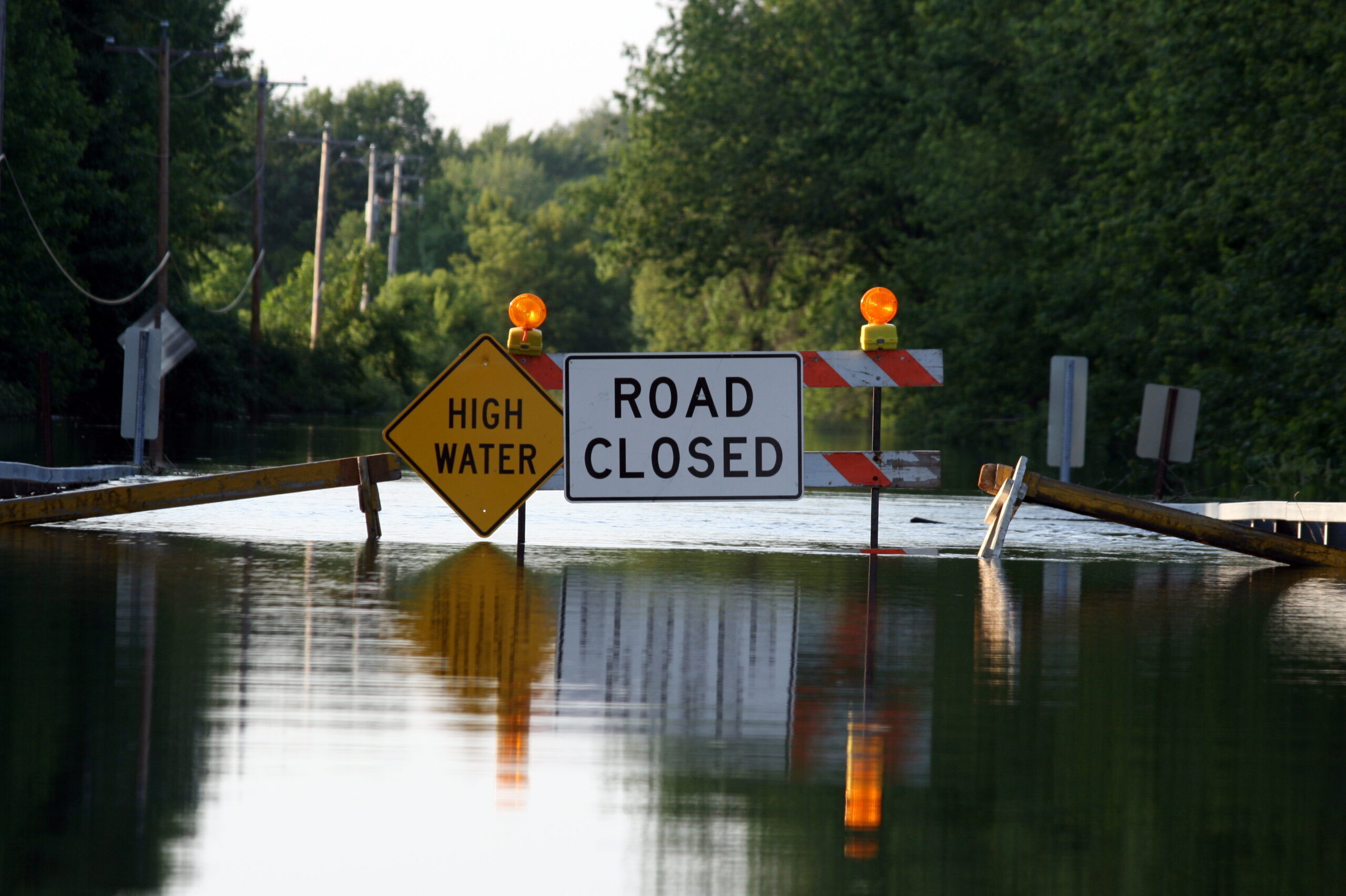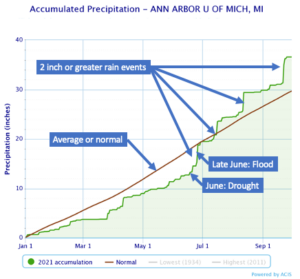What would I do?
Since late June, Southeast Michigan has been very wet. We have seen flooded basements and sodden ground. The graph from the National Weather Service shows the accumulated precipitation, compared to average, from January 1st through September 30th. It shows the year starting in drought. The flood that captured national attention occurred in late June. Then, one can see a sequence of events — featuring two or more inches of rain — that have occurred every two-to-three weeks. I marked them with arrows.
I have done numerous interviews about “floods in Detroit.” We experience flooding from rainfall and flooding from high lake levels. Of course, the two can compound; the high lake levels serve as a dam and inhibit drainage. We are in a situation of persistent water surplus.
Early on in the flood season, I saw many articles about how floods disproportionally affect less affluent neighborhoods. Aside from the vulnerability of individuals, in some cases these neighborhoods had received far less attention than more affluent neighborhoods regarding storm-water management infrastructure. That is, the vulnerabilities were more systemic than the vulnerabilities of one individual’s property.
As the summer continued, I heard my colleagues complain about the continual pumping of their basements and the perils of a failed sump pump. The failed sump pumps might be caused by long periods of electrical outage due to storm damages. Some talked of buying generators that could power an entire house.
Late in the summer, I started getting calls from publications focused on Grosse Pointe and Royal Oak. Reporters serving these more affluent communities had different questions. Most reporters asked, “What would you tell people to do?”
There is a span here, from neighborhoods where residents have limited means (not to mention neglected infrastructure) to communities where individuals can plan to oversee their own backup power and pumping stations. I have no blanket statement of what people should do. It depends on one’s means and on many specific attributes regarding the land and the house where one lives.
I generally deflect the “what would I tell people to do” question and turn it into “how would I think about” the problem if I were in the same situation.
Time to regroup
First, one has to stop thinking, “I will fix this problem by rebuilding to the same specifications and in the same location.”
These floods are unlikely to be a one-off event. Extreme floods that might have been expected once every 100 years will become more common. They will occur perhaps once every 50, 20, or 10 years.
However, more important to our day-to-day lives is the increasing recurrence of rainfall events lasting two days or more. This increase has been about 40 percent since 1960. Though 1960 seems long ago to many people, it is a useful number for thinking about your residence. If you were fortunate, building codes and land-use planning might have considered floods and their recurrence when your house was built. Those planning numbers no longer apply.
It is worth thinking about how to deal with more frequent, severe floods. What if you live in a chronic state of flood? Persistent precipitation abundance will lead to an accumulation of water in the ground. Since basements for a region were approved with some historical groundwater levels in mind, it is likely that accumulation of more groundwater will lead to chronic flooding.
One could react by building back better. This might mean more waterproof barriers for your house, better diversion of water, and bigger pumps. However, what is happening to you is probably happening to your neighbors. If the water table is rising and filling in your basement, it is likely a neighborhood problem.
It is often better to think of community responses, city responses, and even regional responses.
We’re in this together
What you do as an individual might hurt your neighbor. For example, if you improve the drainage from your property, it may flood their property. Likewise, what your neighbor does can hurt you. Think about how all the pieces fit together. Think about better ways to use parks, landscaping, and green infrastructure. Consider the following questions:
- Are there locations where it would be best not to rebuild?
- Am I in a place where I will be fighting a losing battle for the rest of my life?
- Should we unbuild in some places for the benefit of the community?
- Can I motivate my community association to act together?
- Rather than just fixing the problem at hand, what are the things I can do more systematically to anticipate and prepare for future events?
When faced with chronic flooding, some people will overcome the desire to protect, persist, and stay in their homes. They will leave. In fact, insurance companies and agencies such as the Federal Emergency Management Administration (FEMA) might encourage people to leave. Communities erode as a result.
Local governments need to consider what we are learning from today’s extreme events and how that information can help us prepare and design for the future. How do we adapt existing building standards, and how do we even create new standards and zoning practices? How can we educate local planners and engineering firms? What is the financial model?
So many questions, so few answers
October has been so warm that reporters are calling me about how unusual it is. I am trying to steer answers in a different direction. Yes, it is warm. And this year, it is warm and wet. If you compare it to the past, it is hot. But that comparison is moot. We are at the onset of decades of warming. Heat continues to accumulate in the environment. So if it is unusual, it’s because it is on the cool side for the next 30 years.
We can compare today’s weather to the weather of 30-50 years ago. It has changed, and it is disrupting some lives in ways that are financially and psychologically debilitating. Individuals and local government planners need to think, substantively, about what it means to project out 30-50 years. You can bet the weather will be quite different than it is today.
How do we move away from the mentality to “protect and persist” and gain some real security in our changing climate?





Floyd Miller - 1978
This article seems to be just the beginning of a longer narrative about dealing with climate change. It would appear we have missed the opportunity (if there ever was one) to avert the effects of warming the atmosphere and oceans. So the question posed in the last paragraph begs to be expounded upon.
Reply
Frank Wiegand - 1984
Adaptation is key. It is what humans and other species have always done. Bjorn Lomborg and Steve Koonin have recently written books about adapting to climate change. We need more media coverage of what we can do and less media coverage of the “wringing of hands”. Americans have a “Can Do” culture. Let’s do something!
Reply
Norb Roobaert - 1963
In the year 1900 Galveston experienced “The Great Storm” that left over 6,000 people dead. Today in Galveston houses are elevated. Many on piles 15 feet high. We had 6 feet of water surrounding our house during hurricane Ike in 2008. There were very few deaths during Ike. Houses are now built to withstand 100 mph plus winds. Galveston has adapted and continues to do so after every storm. Most of Ike’s water on the Island came from the Bay. A dike is being studied and under consideration.
Reply